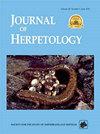龟龟的活动范围、活动模式和栖地使用在不同年龄的龟龟中有所不同吗?
IF 0.8
4区 生物学
Q3 ZOOLOGY
引用次数: 0
摘要
摘要Ornate Box Turtles(Terrapene ornata ornata)在爱荷华州为数不多的大型繁殖种群中存在。关于新生儿和幼龟的活动范围、活动和栖息地使用,以及它们在成熟过程中的活动变化,我们知之甚少。我们追踪了2011年至2016年四个年龄段的海龟,并计算了每周最小凸多边形家园范围、每隔一天移动的线性距离、栖息地、微栖息地和植被覆盖率。根据Ornate Box海龟的既定行为模式,我们将活跃季节分为三个时间段。年龄是解释5月和6月至7月年龄较大的海龟家园范围的唯一重要因素,但在8月至9月期间没有显著差异。然而,在所有时间段内,线性距离随着年龄的增长而显著增加。海龟主要分布在草原或灌木草原栖息地,但年龄较大的海龟更可能远离筑巢/繁殖/越冬区。虽然通常在地表上,但所有年龄组都主要分布在植被、灌木或树木下,这些植被覆盖率>95%。我们建议,对这种受国家威胁物种的栖息地管理应考虑所有年龄段所需的多样性栖息地和面积。本文章由计算机程序翻译,如有差异,请以英文原文为准。
Do Home Range, Movement Patterns, and Habitat Use of Ornate Box Turtles (Terrapene ornata ornata) Differ Among Age Classes?
Abstract. Ornate Box Turtles (Terrapene ornata ornata) exist in few large, reproductive populations in Iowa. Little is known about the home range, movements, and habitat use of neonates and young turtles or how movements change during maturation. We tracked four age classes of turtles from 2011 to 2016 and calculated weekly minimum convex polygon home range, every-other-day linear distance moved, habitat, microhabitat, and vegetation cover. We divided the active season into three blocks of time based on established patterns of behavior in Ornate Box Turtles. Age was the only significant factor explaining larger home ranges in older turtles during May and June–July, but there were no significant differences during August–September. However, linear distance moved significantly increased with age during all time periods. Turtles were mainly found in prairie or shrub–prairie habitats, but older turtles were more likely to move farther away from the nesting/breeding/overwintering area. While often on the surface, all age groups were found primarily under vegetation, shrubs, or trees that provided >95% vegetation cover. We suggest that habitat management for this state-threatened species consider the diverse habitats and area needed by all age classes.
求助全文
通过发布文献求助,成功后即可免费获取论文全文。
去求助
来源期刊

Journal of Herpetology
生物-动物学
CiteScore
1.60
自引率
0.00%
发文量
45
审稿时长
6 months
期刊介绍:
The Journal of Herpetology accepts manuscripts on all aspects on the biology of amphibians and reptiles including their behavior, conservation, ecology, morphology, physiology, and systematics, as well as herpetological education. We encourage authors to submit manuscripts that are data-driven and rigorous tests of hypotheses, or provide thorough descriptions of novel taxa (living or fossil). Topics may address theoretical issues in a thoughtful, quantitative way. Reviews and policy papers that provide new insight on the herpetological sciences are also welcome, but they must be more than simple literature reviews. These papers must have a central focus that propose a new argument for understanding a concept or a new approach for answering a question or solving a problem. Focus sections that combine papers on related topics are normally determined by the Editors. Publication in the Long-Term Perspectives section is by invitation only. Papers on captive breeding, new techniques or sampling methods, anecdotal or isolated natural history observations, geographic range extensions, and essays should be submitted to our sister journal, Herpetological Review.
 求助内容:
求助内容: 应助结果提醒方式:
应助结果提醒方式:


